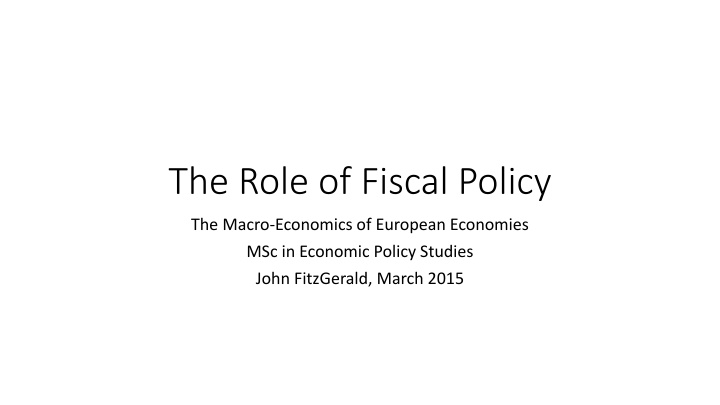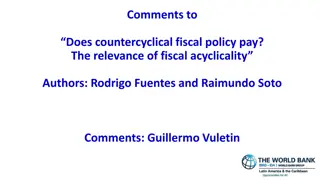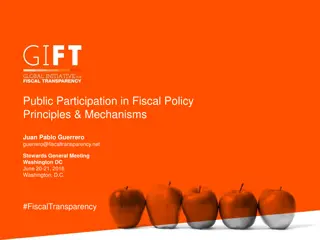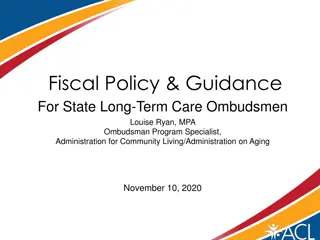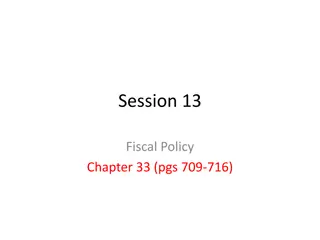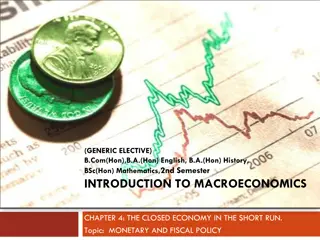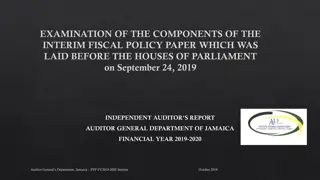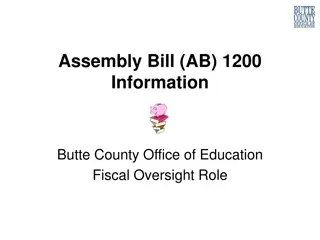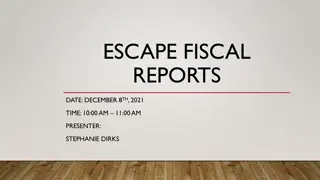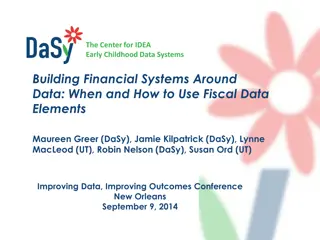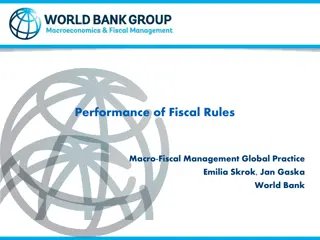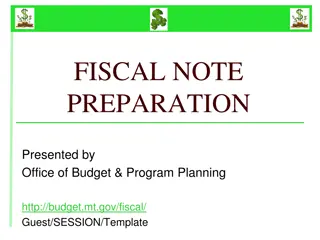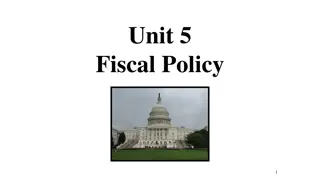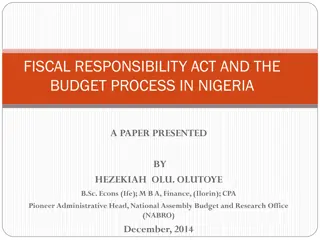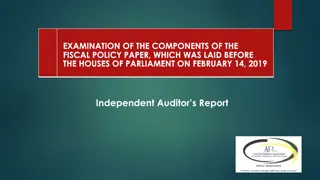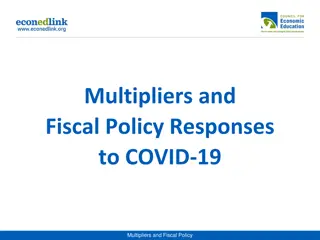The Role of Fiscal Policy
This MSc thesis by John FitzGerald in March 2015 delves into the macroeconomics of various European economies, focusing on the significant impact and strategic importance of fiscal policy. The study examines the effects of fiscal policy on economic development, stability, and growth across these economies, providing valuable insights and analysis. By shedding light on the role and implications of fiscal policy within the context of European economies, this research contributes to understanding the intricate dynamics of economic policy-making.
Download Presentation

Please find below an Image/Link to download the presentation.
The content on the website is provided AS IS for your information and personal use only. It may not be sold, licensed, or shared on other websites without obtaining consent from the author.If you encounter any issues during the download, it is possible that the publisher has removed the file from their server.
You are allowed to download the files provided on this website for personal or commercial use, subject to the condition that they are used lawfully. All files are the property of their respective owners.
The content on the website is provided AS IS for your information and personal use only. It may not be sold, licensed, or shared on other websites without obtaining consent from the author.
E N D
Presentation Transcript
The Role of Fiscal Policy The Macro-Economics of European Economies MSc in Economic Policy Studies John FitzGerald, March 2015
Course Outline 1. How does an economy work? JF 16-1-2015 2. The genesis of macroeconomics AM 23-1-2015 3. Modern macroeconomics AM 30-1-2015 4. Banks and financial markets AM 6-2-2015 5. The recent crisis AM 13-2-2015 6. The labour market JF 20-2-2015 7. Fiscal Policy and forecasting JF 6-3-2015 8. Trade JF 13-3-2015 9. The economics of global warming JF 20-3-2015 10. The future of the Irish economy AM and JF 27-3-2015
Outline of Lecture Theory Objectives of fiscal policy How fiscal policy affects the economy What is the stance of fiscal policy? Sustainability Fiscal Rules Micro-economics of fiscal policy Applied - examples of fiscal policy in operation Irish fiscal policy since 1970 Fiscal adjustment in 1983-93 in Finland and Ireland Fiscal policy since 2008 Fiscal multipliers
Objectives of Fiscal Policy Finance public expenditure on necessary goods and services Keep actual output close to potential Keynesian policy. Fiscal stimulus/tightening when below/above potential Is fiscal fine tuning possible? Sustainability of government debt Ensure that the debt can be services and rolled over, if not repaid In EMU: manage bubbles where interest rates not appropriate Public Finance Choose mix of instruments (taxes and expenditure cuts/increases) to achieve objectives at minimum cost to the economy
Government Sector Revenue and Expenditure Revenue Economic costs of taxation effects on the economy Economic impact of taxation who pays? Other Revenue Expenditure Government Consumption employment of public servants Government Transfers Subsidies Investment Measure of imbalance Deficit or Surplus Debt - sustainability
The goods market Y=C+I+G (+X-M) Y= GDP, output = expenditure = income; I= investment; G= government consumption C=a + b(Y - T) C= consumption;T=Government revenue; a and b are coefficients, where b is 0<b<1 Y=a + bY bT + I + G + (X - M) Y(1-b)= a + I + (X - M) + G - bT ? = 1 ?[? + ? + ? ? + ? ??] Assumes output will respond to an increase in demand 1 ?for T Why are they different? 1 1 ?is the multiplier for G and ? 1
Fiscal Policy & Macro-Economy - 1 1 ? = 1 ?[? + ? + ? ? + ? ??] Change in G change in Y of Implies multiplier > 1; e.g. b=.8 multiplier is 5 Change in T change in Y of ? Implies multiplier < for G; e.g. b=.8 multiplier is -4 Because of leakage through imports, crowding out etc. crude multiplier much lower: e.g. a multiplier of 1.1 1 1 ?where b<1 1 ?where b<1
Fiscal Policy & Macro-Economy - 2 W=f(P, Uf U) Philips curve W=Wage rates; P=Prices; U=unemployment rate; Uf= full employment If U>Ufthen it pulls down wages. If U<Ufthis pushes up wages P=f(W,Pi,ti) Pi= import prices; ti= indirect tax rate L=f(Y,W,Pk,Pm) Where L=employment; Y=output; W= wage rate; Pk=price of capital; Pm=price of materials and other inputs;
Crowding out -1 Government stimulates economy G ; This raises Y; This raises L, which reduces U Lower U leads to higher wages (W) and higher prices (P). Higher W leads to less exports (X) and employment in export industries This is one way that a government stimulus can crowd out exports
Crowding out - 2 Government stimulates economy G ; This raises Y; This raises L which reduces U Lower U leads to higher wages (W) and higher prices (P). Central Bank (ECB) targets inflation If P>P*; where P* is the target rate of inflation Then Central Bank raises interest rates r Higher interest rates affects the cost of investing Lower investment has negative multiplier effects Higher interest rates may also raise the exchange rate and affect competitiveness Crowding out: Through wages affecting exports and Interest rates affecting investment (and also consumption)
The stance of fiscal policy - 1 If unemployment benefit rises in a recession is it a fiscal stimulus? If no change in rates or conditions it is not a policy change not stimulatory. The increase is due to the automatic stabilising role of the public finances If tax revenue rises because of economic growth is that deflationary? If no change in rates or conditions it is not a policy change. The increase is due to the automatic stabilising role of the public finances Distinguish between policy changes and changes induced by developments in the wider economy A fiscal stimulus is an increase in the deficit or reduction in the surplus due to policy action by the government It is the CHANGE in the (structural) deficit surplus, NOT the LEVEL of the surplus or a deficit, that effects change in demand
The stance of fiscal policy - 2 Neutral if keep burden of state unchanged in face of growth Defining a neutral fiscal policy Keep tax rates unchanged Unchanged direct tax rate index bands and credits? Unchanged VAT rate but index excise rates to prices. Property tax a % of value revenue will rise with prices Expenditure Welfare rates (index to price or wage rates?) Public service wage rates link to private sector Employment and volume of investment constant? Indexed price For an example of indexation rules: http://www.esri.ie/UserFiles/publications/QEC2012AUT_SA_Kearney.pdf
The stance of fiscal policy - 3 Government definitions: Tied to legislative change Welfare rates assume unchanged Income tax bands and credits unchanged Where a tax is covered by a sunset clause assume it will end e.g. the levy on pension funds. It is the change in the structural deficit / surplus that matters for management of the economic cycle When government raises (cuts) taxes or (raises) expenditure the effect on borrowing is less than the direct impact. Because cuts deflate the economy other sources of revenue / expenditure affected In Budget allow for revenue buoyancy
Potential Output and Structural Deficit Related to stance of fiscal policy but not identical Identify what is potential output of the economy? To extent actual output is below potential cyclical downturn (or opposite) Without government intervention the cycle will return actual output so it is in line with potential output. The deficit due to the fact that output is below potential is cyclical it will go away without government intervention What is left of the deficit is then structural it needs a tightening of fiscal policy Example: if GDP 5% below potential and the deficit rises by 0.6*GDP Then the cyclical deficit is 3%. If the actual deficit is 4% then the structural deficit is 1% of GDP; the 5% deficit less the effects of the economic cycle of 3%.
EU methodology for structural deficit Potential output Y=AK L(1- )t Where Y=output, K=capital, and L= employment; A and are parameters In the EU methodology L is defined as the level of employment consistent with the non-accelerating wage rate of unemployment or NAWRU. For Ireland currently assume NAWRU over 10% - higher than actual unemployment so Actual output is above Potential output This does not make sense. There is no sign of inflationary pressures even though the unemployment rate is below the EU definition of NAWRU Need a sensible definition of the structural deficit (as it is in the constitution). (Bergin and Fitzgerald, 2014)
Sustainability Ensuring that the state is solvent. Possibility of multiple equilibria. Multiple equilibria: If interest high enough debt cannot be serviced default However, if interest rate low enough any debt is supportable What determines the national interest rate? National rate = world rate + risk premium Risk premia depend on expectations Expectations are unstable they depend on humans!
Sustainability ??+1 ??+1= (1 + ??)?? Where D= public debt; Y= nominal GDP; r=interest rate; B=government primary deficit 1+?? 1+????+ ??+1 Where lower case means that it is a ratio of nominal GDP: e.g. ??+1=??+1 ??+1+??+1 ?? ?? ??+1 ??+1= ??+1 Where ? ?is the rate of growth in nominal GDP ??+1 ??=?? ?? 1+????+ ??+1 For the debt GDP ratio to be stable ??+1=?? 0=?? ?? 1+????+ ??+1; then borrowing, b, must satisfy: ??+1= ??+?? E.g if r=.03; g=.05; d=.6; then b=.012 + interest paid or a deficit of 3% of GDP 1+????
Fiscal Rules Stability and growth pact (SGP) Balanced budget over the cycle; maximum deficit 3%; debt/GDP ratio of 60% Neither observed (Germany and France) nor adequate for the crisis New rules to ensure solvency (creditors get paid) Treaty on Stability, Coordination and Governance (TSCG) Maximum deficit 1% and take measures to get debt back to 60% of GDP Macro-economic imbalances procedure No rules on using fiscal policy to manage the business cycle Are they enforceable? Will they make a difference? See http://www.iiea.com/ftp/Publications/IIEA-Economic-Governance-Paper-1_IIEA_2013.pdf
Fiscal adjustment in the great recession How fast? Credibility What instruments should be used? Expenditure cuts v tax increases? Expenditure: multiplier effects, credibility effects Taxes: tend to be easier and are often reversed credibility See IMF 2010 in references Expectations Ricardian equivalence If people expect the cuts to produce lower taxes in the future, spend today Questionable in practise (Giavazzi and Pagano, 1990, Bradley and Whelan, 1997, IMF 2010) Distributional effects important Because equity matters Because Fairness may affect success of the adjustment
Fiscal Policy under EMU EMU members governed by rules SGP etc. Interest rates are set by the ECB to manage euro area inflation However, inflation rates in individual members may deviate For UK or Sweden, if a housing bubble is developing: use interest rates In EMU must use fiscal policy Run a contractionary policy increase structural surplus/ reduce deficit Also can target housing / property sector through tax system
Micro-economics of fiscal policy Efficiency Considerations Choosing between different tax and welfare instruments. Deadweight losses resulting from taxation (and subsidies). Incidence Types of taxation Direct Indirect Lump sum Pigovian taxes
Deadweight losses If a tax changes behaviour so output falls that is a loss. For example, if the marginal tax rate rises: People will want higher pay or they will work less This will reduce employment and output High deadweight in the 1980s tax system (Honohan and Irvine 1987) Direct taxes (on labour) often have highest deadweight Indirect taxes raise prices and reduce the value of wages. However, payment is shared with those out of the labour force Lump sum taxes Cannot escape them so limited change in behaviour Pigovian taxes e.g. on tobacco and carbon emissions While output may fall there is a societal benefit from the reduction in consumption The problem is that the price does not reflect the cost to society
Incidence The person or company who pays the tax to the revenue may not suffer from the full effects of the tax. If employees pass on some or all of the tax to the employer as higher wages If companies pass on the tax on their product as higher prices. Incidence depends on the supply and demand for a product or service Depends of the market power of the individual or company on whom the tax is levied. Example: Tax on labour in Ireland
Wage Rates The tax wedge: Employers pay W*(1+te); Employees get W*(1-tp) Where te=employers taxes (rate) and tp=employees taxes (rate) The higher the tax wedge the bigger the difference between the 2 wage rates Who pays the taxes on labour where is the incidence? Depends on the shape of the labour supply and demand curves
Tax incidence: affected by labour supply & demand Impose a tax on labour of W1-W3. Labour bargains in terms of after tax wages Labour supply moves from S1 to S2 Labour demand downward sloping Employment falls from L2 to L1 Wage rates rise from W1 to W2 that share of the tax is paid by employer The part of the tax W2-W3 is paid by the employee The flatter more elastic labour supply the bigger the share of the tax is paid by employers increasing the employment effect Partnership in Ireland 1987 trade off tax cuts for wage moderation This reflected the behaviour of the market with an elastic labour supply Other countries labour supply less elastic because limited migration
Elastic Labour Supply Wage Rates W S1L W1 DL L L2 Employment
Elastic Labour Supply Wage Rates S2L W S1L W3 W2 W1 DL L L2 L1 Employment
Distributional Effects Very Important Because society cares about equity Because an unfair tax may come unstuck politically Need a model to determine the effects Because there are no typical families or individuals Also need to take account of incidence
Distributional effect of Budgets Impact of Budgetary Policy 2009-2015 - Percentage Change in Disposable Income by Income Decile
Applied Irish Fiscal Policy since 1970 Fiscal adjustment in Finland and Ireland in the 1980s/1990s Fiscal adjustment in this crisis
Fiscal Policy 1970s Keynesian bias Economics v public perception 1980s Recognition of supply side Economics v public perception Impetus to demand leaks out in current account 1980s fiscal adjustment 1 1990s order restored 2009-14 fiscal adjustment - 2 31
Fiscal Policy 1970-77 1972-3 Stimulated growing economy Because forecasts suggested low growth Suggested danger of fine tuning Mistaken interpretation of oil price shocks Treated as a demand shock not a supply shock Fiscal adjustment Budget for 1977 toughest in 50 years 32
Fiscal Policy Incremental Measure of Fiscal Stance (% of GNP +ve expansionary -ve contractionary) 4 3 2 1 0 -1 -2 -3 -4 -5 -6 1976 1992 1998 1978 1980 1982 1984 1986 1988 1990 1994 1996 2000 2002 2004 2006 2008 2010 2012 33
1977-1981 Fiscal Stimulus Election promises major tax cuts & spending Simplistic Keynesian model No consciousness of what drives real output Limited media or independent assessment Exception: Geary, April 1978 Consequences: e.g. Moneypoint and public service hiring Build up of borrowing and debt when real interest rates low There was a black hole which was not seen Things even worse than they looked on BOP current account Then . 34
Fiscal Policy Incremental Measure of Fiscal Stance (% of GNP +ve expansionary -ve contractionary) 4 3 2 1 0 -1 -2 -3 -4 -5 -6 1976 1992 1998 1978 1980 1982 1984 1986 1988 1990 1994 1996 2000 2002 2004 2006 2008 2010 2012 35
1980s Fiscal Adjustment Problems partly tackled 1983-4 Too much reliance on tax and not enough on cuts Delayed adjustment 1985-6 eased off too early 1987-9 adjustment completed More reliance on expenditure cuts Lessons? External environment very important Get it over with faster More on expenditure than taxation De facto co-operation between 82-87 and 87-89 govts. Myth of an Expansionary Fiscal Contraction 36
Ireland 1980s, Finland 1990s 10 5 0 % of GDP -5 -10 -15 -20 1 2 3 4 5 6 7 8 9 10 11 12 Years of adjustment Ireland Current Account Finland Current Account Ireland Government Borrowing Finland Government Borrowing
Ireland 1980s, UK end of 1980s 5 0 -5 % of GDP -10 -15 -20 1 2 3 4 5 6 7 8 9 10 11 12 Years of adjustment Ireland Current Account Ireland Government Borrowing UK Current Account UK Government Borrowing
Comparison of Adjustments In each case the adjustment in current a/c of BOP occurs first Success of fiscal adjustment takes time to be realised When take tough budgetary action Deflate economy cuts consumption and imports Lower growth tends to push deficit back up (but by less than cuts) Reduces inflationary pressures; Private sector gradually crowded in Exports respond gradually return to growth When no longer deflating economy growth strengthens
Fiscal Policy in the 1990s Economy very competitive & ready to grow in 1990s Signs of rapid growth commencing in 1989 German unification & German monetary policy Delayed the Celtic Tiger, which was purring 1989-90 Fiscal policy broadly stimulatory in 1990s Economy began decade well below potential Fine tuning seen to be difficult 40
Fiscal Policy Incremental Measure of Fiscal Stance (% of GNP +ve expansionary -ve contractionary) 4 3 2 1 0 -1 -2 -3 -4 -5 -6 1976 1992 1998 1978 1980 1982 1984 1986 1988 1990 1994 1996 2000 2002 2004 2006 2008 2010 2012 41
Managing the 2000s boom From 2001 economy began to move too fast Turning point probably 2003 Monetary policy Not able to manage property boom Fiscal policy an answer Belief that fiscal policy no longer useful fine tuning Needed to run an increasing surplus to take steam out Make housing more expensive to reduce demand Irish housing supply squeezed rest of economy Either or both fiscal policy or regulation could have worked Economic advice concentrated on fiscal policy. Lack of attention to financial economics and regulation See http://www.esri.ie/UserFiles/publications/JACB201142.pdf 42
Restoring Order 2009-2015 Size of banking problem underestimated Only clear from autumn 2010 There was a huge hole in the public finances Also a massive increase in welfare expenditure c. 30 billion of cuts, using Dept. Finance (legislative) definitions 9 billion to increase welfare expenditure automatic stabilisers 1 billion to pay for interest on banking debt 20 billion to plug the hole in the public finances 43
Government Transfers as % of GDP Change 2007 2008 2009 2010 2011 2012 2013 2007-2011 Germany 16.0 15.8 17.4 16.7 15.7 15.6 15.7 -0.3 France 17.4 17.6 19.2 19.2 19.1 19.5 19.9 1.7 Netherlands 9.7 9.7 10.7 11.0 11.1 11.5 11.9 1.4 UK 12.1 12.6 14.3 14.2 14.2 14.6 14.5 2.1 Ireland 11.5 13.8 17.7 17.6 17.5 17.5 16.3 6.0 Greece 14.6 16.1 17.6 17.8 19.3 19.8 18.5 4.7 Spain 11.5 12.3 14.4 15.1 15.3 16.0 16.3 3.8 Portugal 14.1 14.6 16.4 16.4 17.0 17.5 18.4 2.9 Source: EU AMECO database. GNP is used for Ireland, not GDP.
Fiscal Policy Incremental Measure of Fiscal Stance (% of GNP +ve expansionary -ve contractionary) 4 3 2 1 0 -1 -2 -3 -4 -5 -6 1976 1992 1998 1978 1980 1982 1984 1986 1988 1990 1994 1996 2000 2002 2004 2006 2008 2010 2012 45
Spanish v Irish approach to adjustment 2010 2011 2012 2013 Plan of: Spain Spring 2010 Spring 2011 Spring 2012 Latest Plan of: Ireland Winter 2009 Winter 2010 Latest 9.8 9.2 7.5 5.3 4.4 5.3 10.3 3 3 3 6 9.4 9.4 6.8 11.6 10 7.2 8.6 7.9 4.9 7.5 5.7 10.6 8.5 10.7
Restoring Order 2009-2015 Apart from avoiding a crisis! Caution in fiscal policy important, asymmetric risks Regulation better safe than sorry Ireland - Tackling the Crisis Under-promise and over-deliver Ireland s plan not the Troika s For EU Bail-outs worked (except Greece). Need EU banking system: EU regulation being delivered Need an appropriate EU fiscal Policy not happening 47
Fiscal stance for euro area Measure by cyclically adjusted deficit Take out effects of recession - a measure of structural deficit Deficit continuously cut 2011-2014 A measure of the EA12 fiscal stance pro-cyclical
Euro 12, Cyclically adjusted deficit, % of GDP UBLGAP_103190_EA12 -1 -2 -3 -4 -5 -6 2006 2007 2008 2009 2010 2011 2012 2013 2014
